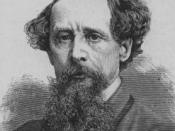In Charles Dickens' renowned novel A Tale of Two Cities the utilization of metaphorical language accentuates the underlying themes such as revolution and the terror that stem from a mob mentality. Revolution, which is the most outstanding theme, can undeniably be associated with every metaphor in the novel. As critic Edgar Johnson noted, "this vision of the Revolution as the relentless consequence of the past luridly illuminates all the scenes of violence and turmoil in A Tale of Two Cities and reverberates even through its last chapter" (975). Charles Dickens employs the major themes of the novel through the extended metaphors of the echoing footsteps, the rising sea, and the golden thread.
The metaphorical echoing footsteps serve to convey several meanings throughout the novel. These multifaceted footsteps further intensify the realm of paradoxes that is quickly engulfing both France and England. This paradoxical existence, as demonstrated in the beginning of the novel with the famous line "it was the best of times it was the worst of times" (1), can be further explored through the characters that are directly associated with the echoing footsteps.
Primarily the footsteps represent the noise made by the hopeful revolutionaries in France as they embark on their conquest of the aristocracy. However, as time progresses and the revolution intensifies, a feeling of despair begins to lurk over the English counterpart of the novel, which is embodied by Lucie Manette. Lucie is England's representation of purity and compassion while her husband Charles Darnay is the embodiment of France. These footsteps are first heard by Lucie but will be deeply felt by her husband very soon. The premonition of doom was surely in the air. "For there was something coming in the echoes, something light, afar of, and scarcely audible yet, that stirred her (Lucie) heart...



A Tale of Two Cities
This is one of the most brilliant essays I have read here. I enjoyed reading it and I am definitely going to borrow that book from the library on Monday. Very good use of language,wonderful vocabulary. I just found a few errors that you may want to correct. For example you said that "It can be clearly sent hat this Revolution" I think you meant "It can clearly be said or stated that"? and also "based his metaphorical rising sea on the studied and research" I think you meant "studies and research".
1 out of 1 people found this comment useful.